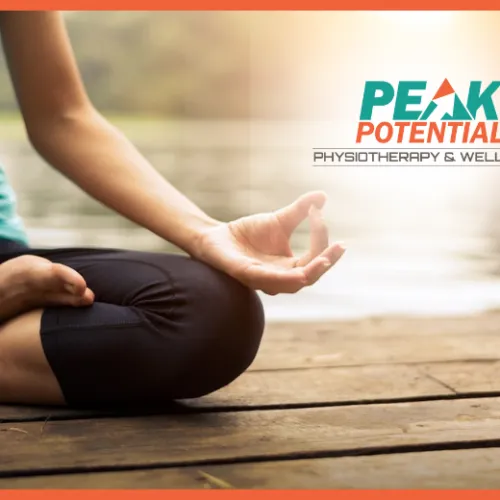Breathing is a necessity of life that occurs without much thought. However, improper breathing can upset the oxygen and carbon dioxide exchange and contribute to anxiety, panic attacks, fatigue, and other physical and emotional disturbances. The next time you’re feeling anxious and can’t fall asleep, try some breathing exercises. Learn one technique below.
Falling asleep or coming down from anxiety might never be as easy as 1-2-3, but some experts believe a different set of numbers – 4-7-8 – comes much closer to doing the trick.
The 4-7-8 technique is a relaxation exercise that involves breathing in for four counts, holding that breath for seven counts and exhaling for eight counts, said Dr. Raj Dasgupta, a clinical associate professor of medicine at the University of Southern California’s Keck School of Medicine, via email.
Also known as the “relaxing breath,” 4-7-8 has ancient roots in pranayama, which is the yogic practice of breath regulation, but was popularized by integrative medicine specialist Dr. Andrew Weil in 2015.
“What a lot of sleep difficulties are all about is people who struggle to fall asleep because their mind is buzzing,” said Rebecca Robbins, an instructor in medicine at Harvard Medical School and associate scientist in the division of sleep and circadian disorders at Brigham and Women’s Hospital in Boston. “But exercises like the 4-7-8 technique give you the opportunity to practice being at peace. And that’s exactly what we need to do before we go to bed.”
“It does not ‘put you to sleep,’ but rather it may reduce anxiety to increase likelihood of falling asleep,” said Joshua Tal, a New York state-based clinical psychologist.
How 4-7-8 works
The 4-7-8 method doesn’t require any equipment or specific setting, but when you’re initially learning the exercise, you should sit with your back straight, according to Weil. Practicing in a calm, quiet place could help, said Robbins. Once you get the hang of it, you can use the technique while lying in bed.
During the entire practice, place the tip of your tongue against the ridge of tissue behind your upper front teeth, as you’ll be exhaling through your mouth around your tongue. Then follow these steps, according to Weil:
- Completely exhale through your mouth, making a whoosh sound.
- Close your mouth and quietly inhale through your nose to a mental count of four.
- Hold your breath for a count of seven.
- Exhale through your mouth, making a whoosh sound for a count of eight.
- Repeat the process three more times for a total of four breath cycles.
Keeping to the ratio of four, then seven and then eight counts is more important than the time you spend on each phase, according to Weil.
Not getting enough sleep? It could be making you more selfish
“If you have trouble holding your breath, speed the exercise up but keep the ratio (consistent) for the three phases. With practice you can slow it all down and get used to inhaling and exhaling more and more deeply,” his website advised.
When you’re stressed out, your sympathetic nervous system – responsible for your fight-or-flight response – is overly active, which makes you feel overstimulated and not ready to relax and transition into sleep, Dasgupta said. “An active sympathetic nervous system can cause a fast heart rate as well as rapid and shallow breathing.”
What research shows

The 4-7-8 breathing practice can help activate your parasympathetic nervous system – responsible for resting and digesting – which reduces sympathetic activity, he added, putting the body in a state more conducive to restful sleep. Activating the parasympathetic system also gives an anxious brain something to focus on besides “why am I not sleeping?” Tal said.
While proponents may swear by the method, more research is needed to establish clearer links between 4-7-8 and sleep and other health benefits, he added.
“There is some evidence that 4-7-8 breathing helps reduce anxious, depressive and insomniac symptoms when comparing pre- and post-intervention, however, there are no large randomized control trials specifically on 4-7-8 breathing to my knowledge,” Tal said. “The research on (the effect of) diaphragmatic breathing on these symptoms in general is spotty, with no clear connection due to the poor quality of the studies.”
A team of researchers based in Thailand studied the immediate effects of 4-7-8 breathing on heart rate and blood pressure among 43 healthy young adults. After participants had these health factors and their fasting blood glucose measured, they performed 4-7-8 breathing for six cycles per set for three sets, interspersed with one minute of normal breathing between each set. Researchers found the technique improved participants’ heart rate and blood pressure, according to a study published in July.
How to get to sleep the night before an early call or big event
When researchers have observed the effects of breathing techniques like 4-7-8 breathing, they have seen an increase in theta and delta brain waves, which indicate someone is in the parasympathetic state, Robbins said. “Slow breathing like the 4-7-8 technique reduces the risk of cardiovascular disease and type 2 diabetes and improves pulmonary function.”
The 4-7-8 technique is relatively safe, but if you’re a beginner, you could feel a little lightheaded at first, Dasgupta said.
What to expect
“Normal breathing is a balance between breathing in oxygen and breathing out carbon dioxide. When you upset this balance by exhaling more than you inhale, (it) causes a rapid reduction in carbon dioxide in the body,” he said. “Low carbon dioxide levels lead to narrowing of the blood vessels that supply blood to the brain. This reduction in blood supply to the brain leads to symptoms like lightheadedness. This is why it is often recommended to start slowly and practice three to four cycles at a time until you are comfortable with the technique.”
The more you practice the 4-7-8 technique, the better you’ll become, and the more your body and mind will incorporate it into your usual roster of tools for managing stress and anxiety, Dasgupta said. Some people combine this method with other relaxation practices such as progressive muscle relaxation, yoga, mindfulness or meditation.
How to tell if your stress levels are normal or a sign of something more
Unmanaged stress can rear its head in the form of sleep difficulties, Robbins said. “But when we can manage our stress over the course of the day (and) implement some of these breathing techniques, we can put ourselves in the driver’s seat instead of being victim to events that happen in our lives.”
Exercise promotes health and can help you get a better night of sleep! Physical activity causes positive reactions in your whole body, increasing blood flow, eliminating toxins, strengthening muscles and joints, and much more. If pain prevents you from living an active life, we can help! Contact us at 901.316.5456 to schedule an appointment or visit our Facebook Page!
Reference: [https://edition.cnn.com/2022/09/16/health/4-7-8-breathing-technique-relaxing-wellness/index.html]


